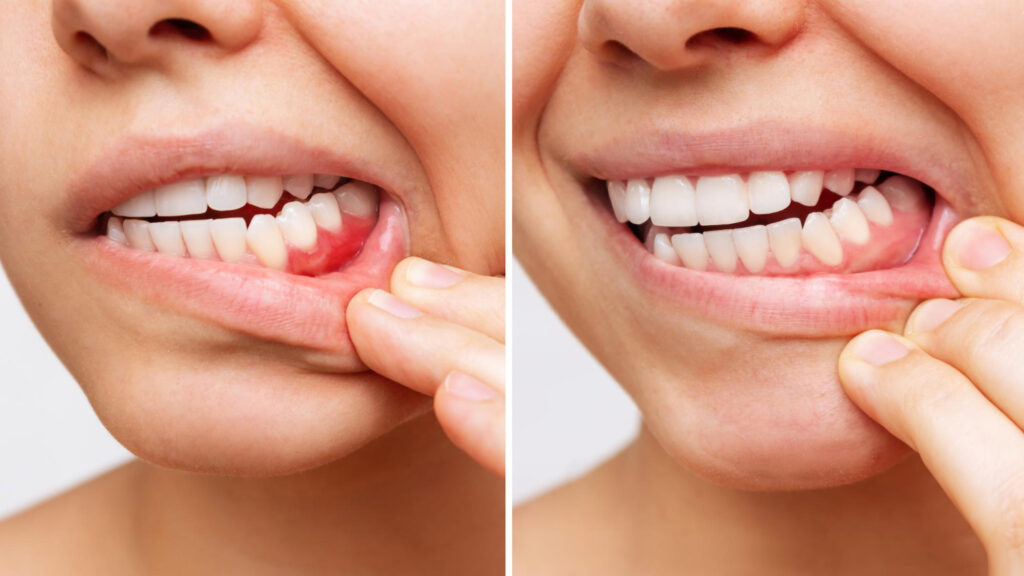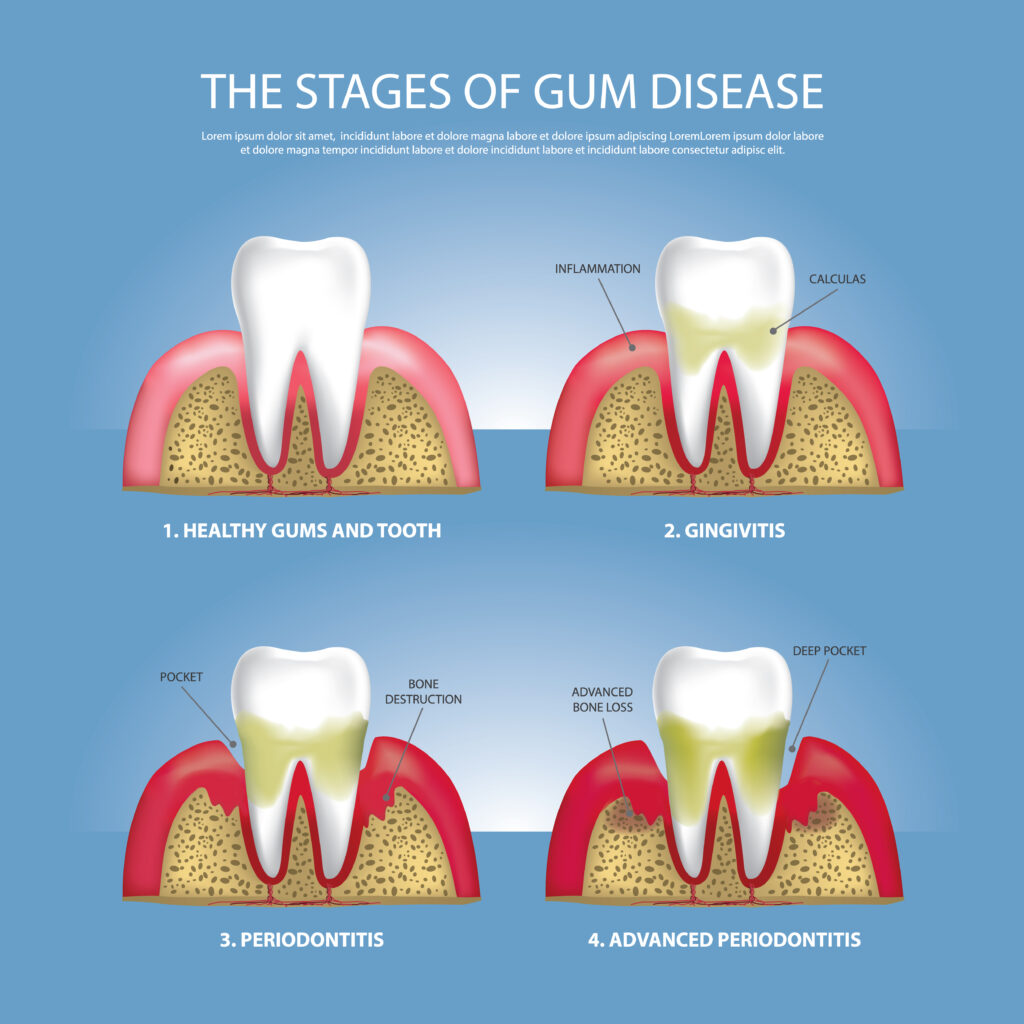Treatment For Gums
Treatment For Gums
Gums, also known as gingiva, are the soft tissues that surround and support teeth. They are the foundation of a healthy smile and play a vital role in oral health. Here’s why your gums are so important:
- Protection and Support: Gums act as a protective barrier, preventing harmful bacteria from entering your bloodstream through your mouth. They also support your teeth, keeping them in their proper positions.
- Nutrient Supply: Gums have a rich blood supply, delivering essential nutrients to your teeth and aiding in their overall health and strength.
- Aesthetic Appeal: Healthy gums contribute to a pleasing smile, framing your teeth beautifully and enhancing your facial aesthetics.

Gum diseases are common oral health issues that can range from mild inflammation to severe infection. It’s essential to identify and treat these conditions promptly.
Gum disease, also known as periodontal disease, is primarily caused by the accumulation of plaque—a sticky, colorless film of bacteria—on the teeth and gums.

Several factors can contribute to the development and progression of gum disease:
- Poor Oral Hygiene: Inadequate brushing and flossing can lead to the buildup of plaque, which can harden into tartar (calculus) and irritate the gums.
- Tobacco Use: Smoking or using smokeless tobacco can significantly increase the risk of gum disease.
- Genetics: Some individuals may be genetically predisposed to gum disease and may have a heightened susceptibility to its development.
- Medical Conditions: Certain systemic conditions, such as diabetes, autoimmune diseases, and certain blood disorders, can increase the risk of gum disease.
- Medications: Some medications, like antihypertensive drugs and anticonvulsants, may affect gum health as a side effect.
- Hormonal Changes: Hormonal fluctuations, such as those during pregnancy, menstruation, and menopause, can make gums more susceptible to gum disease.
- Nutrition: A diet lacking in essential nutrients can weaken the immune system, making it harder for the body to fight off infections, including gum disease.
- Age: Older adults are more susceptible to gum disease due to the cumulative effects of poor oral hygiene over time.
Gum disease often starts with mild symptoms that can progress if left untreated. Being aware of these signs and symptoms is crucial for early detection and intervention:
- Gingivitis: This is the earliest stage of gum disease and is typically characterized by:
– Red, swollen, or puffy gums.
– Gums that bleed easily, especially during brushing or flossing.
– Persistent bad breath (halitosis).
– Mild gum recession.
- Periodontitis: If gingivitis is left untreated, it can progress to periodontitis, which may include:
– More pronounced gum recession, causing teeth to appear longer.
– Formation of pockets or gaps between the teeth and gums.
– Gums that are tender to the touch.
– Increased tooth sensitivity.
– Loose or shifting of teeth.
– Pus between the teeth and gums.
– Changes in the way your teeth fit together when you bite.
- Advanced Periodontitis: If periodontitis continues to progress, it can lead to:
– Severe gum recession, potentially exposing tooth roots.
– Further tooth mobility and potential tooth loss.
– Severe bone loss, resulting in facial changes or a sunken appearance.
It’s essential to consult a dentist or periodontist (gum specialist) if you notice any of these signs or symptoms. Early diagnosis and treatment are critical for preventing the progression of gum disease and preserving your oral health. Regular dental check-ups and professional cleanings can help detect and address gum disease in its early stages.
- Non-Surgical Gum Treatment:
Non-surgical gum treatments are typically the first line of defense against gum disease (periodontal disease) and are effective in managing mild to moderate cases. These treatments aim to reduce inflammation, eliminate infection-causing bacteria, and promote gum tissue healing without the need for surgical intervention. Here are common non-surgical gum treatment options:
- Scaling and Root Planing (Deep Cleaning): This is a common non-surgical procedure where the dental hygienist or dentist removes plaque and tartar from above and below the gumline (scaling) and smoothes the tooth’s root surfaces (root planing) to prevent bacterial buildup. This treatment helps gums reattach to the tooth surfaces.
- Antibiotic Therapy: Local antibiotics may be used in conjunction with scaling and root planing. These antibiotics, such as Arestin, are placed directly into the periodontal pockets to target and eliminate bacteria. They help control infection and promote healing.
- Oral Hygiene Education: Education about proper brushing and flossing techniques is crucial. Patients are taught how to maintain good oral hygiene practices at home to prevent the recurrence of gum disease.
- Dental Cleanings: Regular dental cleanings (prophylaxis) every six months or as recommended by your dentist are essential to prevent the buildup of plaque and tartar and monitor gum health.
- Lifestyle Changes: Smoking cessation, improved nutrition, and stress management may be recommended to address contributing factors to gum disease.
- Surgical Gum Treatment:
Surgical gum treatments are necessary when non-surgical methods are insufficient to address advanced or severe cases of gum disease. These procedures are typically performed by a periodontist, a specialist in gum and bone health. Here are some common surgical gum treatment options:
- Pocket Reduction (Flap) Surgery: In this procedure, the periodontist lifts the gum tissue to access the root surfaces and remove plaque, tartar, and diseased tissue. The gum tissue is then repositioned and sutured back into place, reducing the size of periodontal pockets.
- Bone Grafting: Severe gum disease can lead to bone loss around the teeth. Bone grafting involves adding bone or bone substitutes to regenerate lost bone and provide a stable foundation for teeth.
- Soft Tissue Grafting: For cases of gum recession or insufficient gum tissue, soft tissue grafts may be performed. This involves taking tissue from another part of the mouth or using donor tissue to augment gum coverage and protect tooth roots.
- Guided Tissue Regeneration: This technique involves placing a barrier membrane between the gum and bone to prevent gum tissue from growing into areas where bone regeneration is needed, allowing bone to regrow.
- Laser Gum Surgery: Some periodontal procedures can be performed using lasers, which offer precision, reduced discomfort, and faster healing times. Laser therapy can target infected tissue, remove it, and stimulate tissue regeneration.
The choice between non-surgical and surgical gum treatment depends on the severity of gum disease and individual patient needs that the periodontist advises after assessing the condition and recommends the most appropriate treatment plan to restore your oral health.
Cosmetic Gum Treatments:
- Gummy Smile Correction: A gummy smile can affect your confidence. We offer minimally invasive treatments to reshape your gumline and reveal more of your teeth, creating a harmonious and balanced smile.
- Gum Depigmentation: Dark or discolored gums can be a cosmetic concern. Our depigmentation procedures lighten the gum tissue, enhancing your smile’s aesthetics.
Other Services
Free Virtual Consultation
We will get back to you shortly
